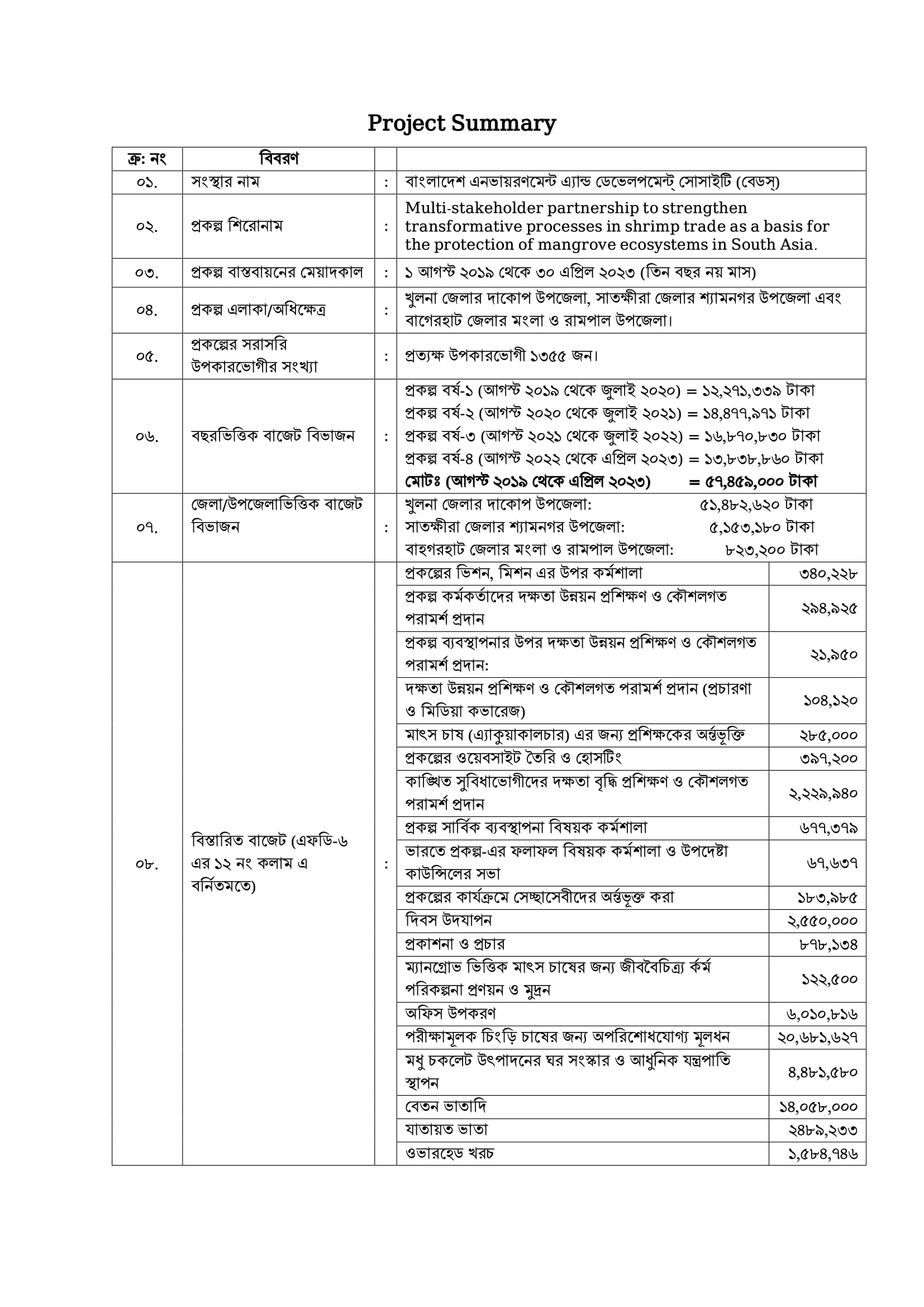Head office:
Multi-purpose IMA (Integrate Mangrove Aquaculture) BuildingPaschim Dhangmari, Banishanta Union, Dacope, Khulna
Contact no.: +880 1968 809517
Email: [email protected]
Website: https://www.bedsbd.org/projects/ongoing-projects/4
The mangrove forests of the tropical coasts are among the most important and productive ecosystems on the earth. They play an important role in stabilizing the world's climate by high carbon storing capacity. They are the nursery of countless fish species that are important for inshore fishing, and they also protect the coastal population from tropical cyclones by reducing its frequency and intensity. But in recent decades, these productive ecosystems have come under severe pressure. Since 1980, their populations have declined by 20 percent worldwide. One of the main factors for their destruction is the unchecked spread of shrimp aquaculture - especially in the countries of South and Southeast Asia. Due to the lack of mangrove protection, tropical cyclones sweep across the Sundarbans of Bangladesh, which are claiming many lives, destroying houses, damages agricultural crops and lands. Most of the people have moved to cities due to the destruction, the remaining mangrove forests are becoming a refuge for less mobile parts of the population without alternative possibilities which increases pressure to use the remaining natural resources. Another problem of shrimp and crab aquaculture is that the demand for pathogen-free shrimps and crabs for breeding cannot be satisfied by the existing hatcheries. As a result, a considerable proportion of shrimp larvae and young crabs are still caught in the wild in mangrove areas to fulfill the demand. In Bangladesh, another problem is a number of middlemen (up to six) are involved in value chain by selling shrimps and crabs to processors and exporters which lead to economic discrimination of farmers and limit their position in the supply chain. In this context, Sustainable Aquaculture in Mangrove Ecosystems (SAIME) has emerged as an ecosystem-based approach for mangrove protection as well as the livelihood improvement of the aquafarmers in transboundary Sundarbans. Overall goal of the project is to promote healthy mangroves, thriving coastal communities, and robust aquaculture value chains in the Sundarbans: India, Bangladesh, and beyond. The objective of the project are to promote the sustainable management and special protection of mangroves through consolidated dialogue structures of multi-stakeholder partnership and interaction along the value chain of shrimp aquaculture and secures the livelihoods of shrimp fry collectors, fishermen and farmers in India and Bangladesh.

SAIME is an extensive form of low-cost aquaculture which is called Integrated Mangrove Aquaculture (IMA), with low stocking densities constituting black tiger shrimp as a candidate species and with no supplementary feed input. Mangroves are planted along pond embankments and dykes of the SAIME farms. The mangroves planted on the farms increase biodiversity in the farming areas and have positive effects on aquaculture such as leaf litter serves as a source of food for the shrimps and other fishes simulating almost the natural condition. SAIME has been implemented at a pilot-scale for last three years in both India and Bangladesh. In Bangladesh, 20 IMA farms have been demonstrated at Paschim Dhangmari village under Dacope sub district of Khulna district where the farmers cultivate hatchery raised shrimp and other local fishes and plant mangrove saplings inside of the farm according to the land alleviation of the farms. In this integrated approach, it has been observed that the fish farmers are having better yield from the modified extensive polyculture with better survivability of the black tiger shrimp and reduction of deadly viral disease outbreak. For the accomplishment of SAIME, mangrove saplings are an important element. But there was no such mangrove nursery in this region. Community based mangrove nursery has been established where women run the mangrove nurseries and now the mangrove raised saplings are in high demand due to the survivability rate of the saplings.

| Duration | August 2019 to June 2023 |
|---|---|
| Project Location | The Sundarbans coastal region i.e Khulna, Bagerhat and Satkhira districts under Khulna division of Bangladesh. |
| Theme | Livelihood and Mangrove Ecosystem |
| Partner/Collaborators | Global Nature Fund (GNF), Naturland, Nature Environment and Wildlife Society (NEWS) |
| Donor | Ministry of Economic Cooperation and Development (BMZ) |
| SDGs |



.png)

|
Survivability and growth of the planted mangroves species along the pond embankments have been found good. Establishment of mangrove nurseries integrating the women is also catering the need of the mangrove saplings for plantation and also simultaneously providing an alternative income opportunity of the coastal women. Thus, through SAIME, sustainable aquaculture management and protection to mangrove ecosystem can be achieved together creating a scope for developing a community-inclusive value chain along the shrimp trade ensuring the livelihood security of coastal fish farmers in the context of climate change induced global sea level rise (SLR).

SAIME secretariate has been established and BEDS acts as a backbone organization in SAIME secretariate. SAIME secretariate will act as a focal point for disseminating the information from field level to government level.
The multi-stakeholder partnership (MSP) to be created within this project shall encourage all relevant interest groups connected to the value chain of shrimp farming involving civil society, private sector, scientific and public stakeholders to a high degree of involvement and commitment.
Within the framework of a stakeholder dialogue, the interests of relevant parties as well as internal and external factors can be considered and integrated into the project. A formal structure to promote change, cooperation and commitment are built and common goals and necessary measures are formulated. Through a continuous monitoring process, the multi-stakeholder partnership finally supports the effective implementation and necessary reorientation of activities and strategic planning.